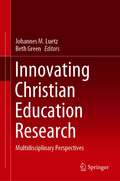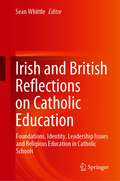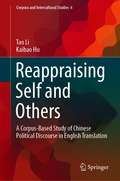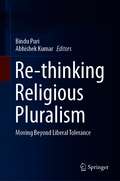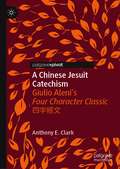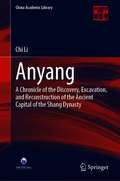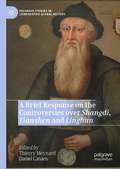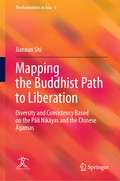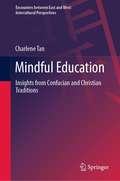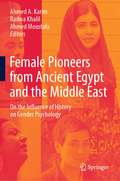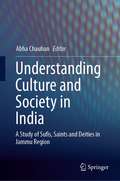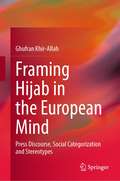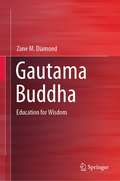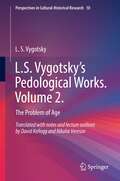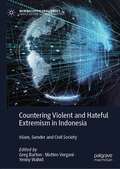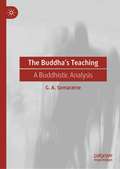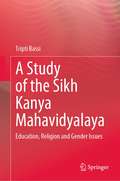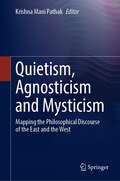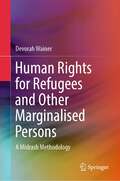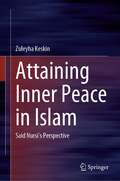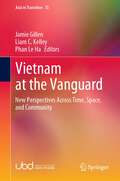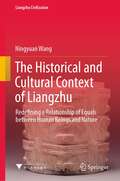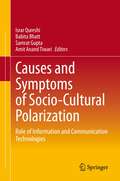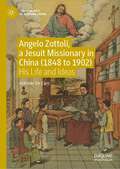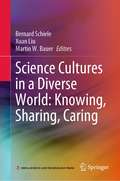- Table View
- List View
Innovating Christian Education Research: Multidisciplinary Perspectives
by Johannes M. Luetz Beth GreenThis book reformulates Christian education as an interdisciplinary and interdenominational vocation for professionals and practitioners. It speaks directly to a range of contemporary contexts with the aim of encouraging conceptual, empirical and practice-informed innovation to build the field of Christian education research. The book invites readers to probe questions concerning epistemologies, ethics, pedagogies and curricula, using multidisciplinary research approaches. By helping thinkers to believe and believers to think, the book seeks to stimulate constructive dialogue about what it means to innovate Christian education research today.Chapters are organised into three main sections. Following an introduction to the volume's guiding framework and intended contribution (Chapter 1), Part 1 features conceptual perspectives and comprises research that develops theological, philosophical and theoretical discussion of Christian education (Chapters 2-13). Part 2 encompasses empirical research that examines data to test theory, answer big questions and develop our understanding of Christian education (Chapters 14-18). Finally, Part 3 reflects on contemporary practice contexts and showcases examples of emerging research agendas in Christian education (Chapters 19-24).
Irish and British Reflections on Catholic Education: Foundations, Identity, Leadership Issues and Religious Education in Catholic Schools
by Sean WhittleThis volume presents an interdisciplinary and systematic review of Catholic Education Studies across Ireland and Britain. Taken together, the chapters drill down to the foundations, identity and leadership matters in Catholic education and schools. It is in reading the complete volume that a more precise picture of Catholic education in Ireland and Britain develops into sharper focus. This is important because it reflects and crystallises the complexity which has almost organically developed within the field of Catholic Education Studies. It also provides a powerful antidote to the naïve reductionism that would boil Catholic education down to just one or two fundamental issues or principles. Contemporary Catholic education, perhaps globally but certainly in Ireland and Britain, is best depicted in terms of being a colourful kaleidoscope of differing perspectives. However this diversity is ultimately grounded in the underlying unity of purpose, because each of the contributors to this volume is a committed advocate of Catholic education.The volume brings together a rich range of scholars into one place, so that these voices can be listened to as a whole. It includes contributions from leading scholars, blended with a plethora of other voices who are emerging to become the next generation of leading researchers in Catholic education. It also introduces a number of newer voices to the academic context. They present fresh perspectives and thinking about matters relating to Catholic education and each of them confidently stand alongside the other contributors. Moreover, these reflections on Catholic education are important fruits to have emerged from the collaboration made possible through the creation of the Network for Researchers in Catholic Education, which was established in 2016 under the auspices of Heythrop College, University of London.
Reappraising Self and Others: A Corpus-Based Study of Chinese Political Discourse in English Translation (Corpora and Intercultural Studies #6)
by Tao Li Kaibao HuThis book is a valuable resource for those involved in translation studies and discourse analysis. Drawing on a corpus-based approach and a combined framework of Appraisal and Ideological Square, this book investigates the variations in stance towards China and other countries in the English translation of contemporary Chinese political discourse. It presents research findings based on comparisons and statistical analyses of the English translation patterns of appraisal epithets, the most prototypical appraisal resources for evaluation, in Chinese political discourse at both lexico-grammatical and discourse semantic levels.
Re-thinking Religious Pluralism: Moving Beyond Liberal Tolerance
by Bindu Puri Abhishek KumarThis book combines the mainstream liberal arguments for religious tolerance with arguments from religious traditions in India to offer insights into appropriate attitudes toward religious ‘others’ from the perspective of the devout. The respective chapters address the relationship between religions from a comparative perspective, helping readers understand the meaning of religion and the opportunities for interreligious dialogue in the works of contemporary Indian philosophers such as Gandhi and Ramakrishna Paramhansa. It also examines various religious traditions from a philosophical viewpoint in order to reassess religious discussions on how to respond to differing and different religious others. Given its comprehensive coverage, the book is of interest to scholars working in the areas of anthropology, philosophy, cultural and religious diversity, and history of religion.
A Chinese Jesuit Catechism: Giulio Aleni’s Four Character Classic 四字經文 (Christianity in Modern China)
by Anthony E. ClarkThis book is the first scholarly study of the famous Jesuit Chinese children’s primer, the Four Character Classic, written by Giulio Aleni (1582–1649) while living in Fujian, China. This book also includes masterful translations of both Wang Yinglin’s (1551–1602) hallowed Confucian Three Character Classic and Aleni’s Chinese catechism that was published during the Qing (1644–1911). Clark’s careful reading of the Four Character Classic provides new insights into an area of the Jesuit mission in early modern China that has so far been given little attention, the education of children. This book underscores how Aleni’s published work functions as a good example of the Jesuit use of normative Chinese print culture to serve the catechetical exigencies of the Catholic mission in East Asia, particularly his meticulous imitation of Confucian children’s primers to promote decidedly Christian content.
Anyang: A Chronicle of the Discovery, Excavation, and Reconstruction of the Ancient Capital of the Shang Dynasty (China Academic Library)
by Chi LiThis book presents an anthology of English-language archaeological and anthropological writings by Li Chi, the founding father of modern archaeology in China. It is divided into 15 chapters; in the first two, Dr. Li sets the stage by introducing the principal characters involved in the first “act” of this modern archaeological drama; in the third and fourth chapters, he describes the status of Chinese archaeology during the early years of the twentieth century and highlights the contributions of prominent foreigners. Starting with the fifth chapter, Dr. Li begins detailing the excavations and describes the principle finds of the Anyang expedition. In turn, the book’s closing chapters present a summary of the findings and descriptions of some of the major publications that this monumental project has yielded. For readers who are interested in Chinese civilization, what will appeal to them most are the details of the excavations of Yin Hsü (the ruins of the Yin Dynasty), including building foundations, bronzes, chariots, pottery, stone and jade, and thousands of oracle bones, which are vividly shown in historical pictures. These findings transformed the Yin Shang culture from legend into history and thus moved China’s history forward by hundreds of years, shocking the world. The anthology also includes Li Chi’s reflections on central problems in Chinese anthropology, which are both enlightening and thought-provoking.
A Brief Response on the Controversies over Shangdi, Tianshen and Linghun (Palgrave Studies in Comparative Global History)
by Thierry Meynard Daniel CanarisThis book represents the first critical edition and scholarly annotated translation of a pioneering report on the predicament of cross-cultural understanding at the dawn of globalization, titled “A Brief Response on the Controversies over Shangdi, Tianshen and Linghun” (“Resposta breve sobre as Controversias do Xámtý, Tien Xîn, Lîm hoên”), which was written in China by the Sicilian Jesuit missionary Niccolò Longobardo (1565–1654) in the 1620s and profoundly influenced Enlightenment understandings of Asian philosophy. The book restores the focus on Longobardo’s own intellectual concerns, while also reproducing and analyzing all the Chinese-language annotations on the previously unpublished Portuguese and Latin manuscripts. Moreover, it meticulously modernizes all romanizations with standard Hanyu pinyin and identifies, on the basis of archival research, most of Longobardo’s Chinese interlocutors, thus providing new insights into how the Jesuits networked with Chinese scholars in the late Ming. In this way, it opens up this seminal text to Sinologists and global historians exploring Europe’s first intellectual exchanges with China. In addition, the book presents four introductory essays, written by the editors and two prominent scholars on the Jesuit China mission. These essays comprehensively reconstruct the historical and intellectual context of Longobardo’s report, stressing that it cannot be viewed purely as a product of Sino-European cultural exchange, but also as an outgrowth of both exegetic debates within Europe and of European experiences across Asia, especially in Japan. Hence this critical edition will greatly contribute to a more globalized view of the Jesuit China mission.
Mapping the Buddhist Path to Liberation: Diversity and Consistency Based on the Pāli Nikāyas and the Chinese Āgamas (The Humanities in Asia #9)
by Jianxun ShiDue to the diversity in Buddhism, its essence remains a puzzle. This book investigates the Buddhist path to liberation from a practical and critical perspective by searching for patterns found in the Pāli Nikāyas and the Chinese Āgamas. The early discourses depict the Buddhist path as a network of routes leading to the same goal: liberation from suffering. This book summarizes various teachings in three aspects, provides a template theory for systematically presenting the formulas of the sequential training of the path, and analyses the differences and similarities among diverse descriptions of the path in the early Buddhist texts. By offering a comprehensive map of the Buddhist path, this book will appeal to scholars and students of Buddhist studies as well as those practitioners with a serious interest in the Buddhist path.
Mindful Education: Insights from Confucian and Christian Traditions (Encounters between East and West)
by Charlene TanThis book provides original ideas and practical recommendations for educators in a post-pandemic world. We live in a world that has been upended by the COVID-19 pandemic. Students around the globe have been besieged by disruptions that threaten not only their academic learning but also their mental, emotional, and interpersonal well-being. In the midst of pressing and mounting challenges, how can schools ensure the total wellness of all their students? Beyond reactive, piecemeal, and short-term measures, how can schools enact mindful education that pays attention to wholeness in every student? Extending the current research on well-being and mindfulness, this book draws insights from Confucian and Christian traditions. These two traditions have been selected as they are widely seen to represent, and have impacted, Eastern and Western civilisations respectively for millennia. Informed and inspired by Confucian and Christian perspectives, this book proposes that mindfulness is an orientation towards wholeness, where one experiences he (harmony) and shalom (peace). Mindful education is realised through: A school community of ren (humanity) and agape (love); A transforming curriculum that centres on dao (way) and imago dei (god’s image); Empathic teachers who are motivated by shu (putting oneself in the other’s place) and the Golden Rule (do to others as you would have them do to you); and Self-directed learners who develop themselves through xiuji (self-cultivation) and spiritual disciplines. Applying ancient wisdom to contemporary settings, this book on promoting student well-being through mindful education is a useful resource for policymakers, educators, researchers, and general readers.
Female Pioneers from Ancient Egypt and the Middle East: On the Influence of History on Gender Psychology
by Ahmed Moustafa Ahmed A. Karim Radwa KhalilThis book explores the contributions of Eastern female pioneers in science, politics and arts from Ancient Egypt to modern times, and discusses the possible psychological and social impact of this knowledge on today’s gender role in Eastern and Western Societies. Based on psychological studies on social learning, the book argues that profound knowledge of the historical contributions of Eastern female pioneers in science, politics and arts can improve today’s gender roles in Middle Eastern countries and inspire young women living in Western Societies with Eastern migration background. Spanning disciplines such as Natural sciences, Neuroscience, Psychology, Sociology, Islamic Theology, History and Arts, and including contributions from diverse geographical regions across the world, this book provides an elaborate review of the gender role of women in Ancient Egypt and the Middle East, outlining their prominence and influence and discusses the possible psychological and social impact of this knowledge on today’s gender roles.
Understanding Culture and Society in India: A Study of Sufis, Saints and Deities in Jammu Region
by Abha ChauhanThis book is an in-depth account of people’s cultural and religious life in the Jammu region of Jammu and Kashmir, India. It brings out the significance of Sufi and deity shrines as alternative places of worship that give meaning and purpose to people’s lives. It includes sites and practices commonly associated with Islam/Sufism and Hinduism as spaces of shared culture. Most of the existing literature of Jammu and Kashmir is on Kashmir focusing mostly on topics such as politics, state, identity, conflict or violence. This book proposes to go beyond these works by delimiting the focus and area of the study to culture, society and religion. It explores the sites of religious pluralism and tolerance in the violence-ridden territory of Jammu and Kashmir. The chapters are mainly based on ethnographic data collected through qualitative methods like observation – participant and non-participant, case studies, in-depth interviews and oral history. The book is of interest to researchers, both faculty and graduate students, in the areas of sociology of religion, social anthropology, religious studies, cultural studies, Sufism, shrines and deity worship in South Asia.
Framing Hijab in the European Mind: Press Discourse, Social Categorization and Stereotypes
by Ghufran Khir-AllahThis book compares how British and Spanish media have covered the French ban on hijab wearing in public schools. Using interdisciplinary approaches ranging from social psychology, semiology, cognitive linguistics and sociology, it seeks to explain how the hijab is interpreted as a sign by the mainstream culture, and hijab-wearing Muslim sub-culture. Based on an analysis of 108 articles published in the national newspaper from each context, this comparative study operates on two levels: a micro-level analysis of within-culture variations between mainstream culture and the hijab-wearing women; and a macro-level analysis of the cross-cultural variation between the British context and the Spanish one. The result is a profound insight into how each discourse reveals the different level of social integration of hijab-wearing women in these two different contexts. The Analysis methodology combines between Critical Discourse Analysis CDA, Conceptual Metaphor Theory CMT, and Cognitive Linguistics CL. The book introduces a novel analysis methodology for social and linguistic sciences. It is the Cognitive Critical Discourse Analysis methodology CCDA.
Gautama Buddha: Education for Wisdom
by Zane M. DiamondThis book examines some of the key elements of Buddhist education theory, in particular about educating for wisdom, the ultimate goal of Buddhist education. The teachings of Gautama Buddha have endured for thousands of years carried into the present era in schools, universities, temples, personal development courses, martial arts academies and an array of Buddhist philosophical societies across the globe. Philosophically, the ideas of the Buddha have held appeal across many cultures, but less is known about the underlying educational theories and practices that shape teaching and learning within Buddhist-inspired educational contexts. The chapters outline the development of the Buddha’s teachings, his broad approach to education and their relevance in the 21st century. Subsequently, the book reviews the history of the evolution of the various schools of Buddhist thought, their teaching and learning styles and the dissemination among Asia and later also the Western countries. The book discusses education theories and devices embedded within the Buddhist teachings, examining the works found in the Tipitaka, the Buddhist canon.
L.S. Vygotsky’s Pedological Works. Volume 2.: The Problem of Age (Perspectives in Cultural-Historical Research #10)
by L.S. VygotskyThis book is the second volume in a series presenting new English translations of L.S. Vygotsky’s writings on the holistic science of the child he called “pedology”. It presents unique materials which reflect the development of Vygotsky’s theoretical position at the last stage of his creative evolution in 1932-1934 and contributes to the number of original Vygotsky texts available in English. It includes the problem of age and age periodization; the structure and dynamics of age, psychological characteristics of age crises and diagnostics of development in relation to age, and the zone of proximal development, which became his most widely known but least understood theoretical innovation. This book places that concept in its context and makes it fully understandable for the first time. In addition, there are lectures and notes that Vygotsky made in preparation for lectures on six critical periods: birth, one year old, three, seven, and thirteen. Vygotsky also devotes chapters to the stable periods of infancy and early childhood and two whole chapters to school age. Future volumes in this series will explore Vygotsky’s pedology of the adolescent.
Countering Violent and Hateful Extremism in Indonesia: Islam, Gender and Civil Society (New Security Challenges)
by Greg Barton Matteo Vergani Yenny WahidThis book provides an overview of preventing and countering violent extremism (P/CVE) to assist readers in developing a more complete understanding of P/CVE and the issues of radicalisation, disengagement and rehabilitation. It shines a light on some key P/CVE programmes and initiatives in Indonesia and is written to facilitate understanding preventing and countering violent extremism in a larger frame. It is intended to be of interest to civil society activists, security practitioners, communities, policy makers and researchers alike. It represents a collaboration, born out of partnership in the field, that brings together academic researchers and civil society activists from Indonesia and Australia. Around the world, far too little is known about Indonesian society in general and Indonesian Islam and civil society in particular. This is, in large measure, because of the barrier of language. This book represents a small, but hopefully significant, contribution to opening a window to Indonesia. The focus of this book is on the challenging issues entailed with violent and hateful extremism. The initiatives it portrays and the people it describes, and whose voices it channels, are filled with the hope of transforming the world to make it better.
The Buddha’s Teaching: A Buddhistic Analysis
by G. A. SomaratneThis book approaches the Dhamma, the Buddha’s teaching, from a Buddhistic perspective, viewing various individual teachings presented in hundreds of early discourses of Pali canon, comprehending them under a single systemic thought of a single individual called the Buddha. It explicates the structure of this thought, going through various contextual teachings and teaching categories of the discourses, treating them as necessary parts of a liberating thought that constitutes the right view of one who embraces the Buddha’s teaching as his or her sole philosophy of life. It interprets the diverse individual dhammas as being in congruence with each other; and as contributory to forming the whole of the Buddha’s teaching, the Dhamma. By exploring some selected topics such as ignorance, configurations, not-self, and nibbāna in thirteen chapters, the book enables readers to understand the whole (the Dhamma) in relation to the parts (the dhammas), and the parts in relation to the whole, while realizing the importance of studying every single dhamma category or topic not for its own sake but for understand the entirety of the teaching. This way of viewing and explaining the teachings of the discourses enables readers to clearly comprehend the teaching of the Buddha in early Buddhism.
A Study of the Sikh Kanya Mahavidyalaya: Education, Religion and Gender Issues
by Tripti BassiThis book addresses the issue of Sikh women’s education in Punjab within the larger discourse of women’s education in India. It focuses on the role of the Sikh Kanya Mahavidyalaya (SKM)—one of the most important educational institutions established in the nineteenth century as a result of the Sikh reformist movement in Punjab. It explores how various dimensions of caste, class, gender and religion generate a variety of approaches to the culture of literacy, and takes a closer look at the relevance of the Sikh Kanya Mahavidyalaya in today’s India and its contribution to the area of educational pedagogy. It focuses on gender in education, specifically discourses and practices in women’s education. In addition to providing valuable insights and critical evidence that can be used in the planning and implementation of education and gender policies, the book is sure to spark conversations in courses and professional communities interested in education, gender studies, history, sociology as well as overlooked dimensions of gender history.
Quietism, Agnosticism and Mysticism: Mapping the Philosophical Discourse of the East and the West
by Krishna Mani PathakThis book presents a unique collection of papers on various philosophical aspects of the unknown and unvoiced truth and reality of the cosmic world. It offers a systematic analysis of the three philosophical theories of Quietism, Agnosticism and Mysticism and introduces readers to the fundamentals of mystical knowledge claimed by philosophical schools of the east and the west. It discusses, debates and deliberates on philosophical issues concerning the acquisition of truth, its objectivity and its various dimensions along with the application of thoughts pertaining to Quietism, Agnosticism, and metaphysical-mystic traditions in philosophy. It examines and precisely defines the scope and limits of knowledge, the respective way of life, its expressions and morality, mystical revelation, ineffability of the ultimate, value realism, and faith and reason - with a primary focus on the classical Indian schools of Hinduism, Buddhism, Jainism, Agnosticism, the Bāuls, Greek traditions, modern western meta-philosophy, and contemporary quietist debate in religion and theology. This insightful collection should be of great interest to independent researchers, students and teachers of philosophy, theology, Mysticism and Agnosticism, cultural studies and religious studies.
Human Rights for Refugees and Other Marginalised Persons: A Midrash Methodology
by Devorah WainerThis book provides a new framework for conducting qualitative research into Asylum Seeking Refugees based on Emmanuel Levinas’ ethic of the face-to-face encounter. The methodology originates in the term Midrash—a narrative form that exposes; investigates; searches. It reconceptualises encounters between Asylum Seeking Refugees and those researching their experiences in a manner that moves beyond the possibility of ‘Othering’ and the removal of ‘voice’ that can characterise research into refugees. This methodology allows a complex and rich multidimensional text, with heterogeneity of voices, experiences, and subjects. As a phenomenological method of research, the internal phenomena of the researcher—feeling, intuition, and personal perception—are legitimate sites of knowledge and understanding, and are not considered separate from the external, objectively observable world. While the researcher is not researching herself, she is also not separate from the research field and data. The Midrash methodology is an honest and explicit method of research designed to (re)invigorated the passion of academics and researchers.
Attaining Inner Peace in Islam: Said Nursi’s Perspective
by Zuleyha KeskinThis book discusses inner peace from an Islamic theological and spiritual perspective, the writings of Said Nursi, a twentieth century Muslim scholar. Inner peace is a topic of great interest in the world at present. While happiness and mental health have been extensively discussed from a psychological and sociological perspective, and while inner peace has been written about from various religious viewpoints, there is very little scholarly work on inner peace from an Islamic theological and spiritual perspective. This book addresses this significant gap. With Islam being the second largest religion in the world, this book provides an important contribution to the literature on a faith tradition which is followed by so many. In addressing the intersection between Islam, spirituality and psychology, this book makes an original contribution to the literature on modern Islamic thinkers like Nursi, and to the broader fields of Islamic studies, and theology, philosophy and well-being studies.
Vietnam at the Vanguard: New Perspectives Across Time, Space, and Community (Asia in Transition #15)
by Le Ha Phan Jamie Gillen Liam C. KelleyThis transdisciplinary edited book explores new developments and perspectives on global Vietnam, touching on aspects of history, identity, transnational mobilities, heritage, belonging, civil society, linguistics, education, ethnicity, and worship practices. Derived from the Engaging With Vietnam: An Interdisciplinary Dialogue conference series, this cutting-edge collection presents new scholarship and also represents new ways of knowing global Vietnam. Over the past 10 years, knowledge production about Vietnam has diversified in various ways as globalization, the internationalization of higher education, and the digital revolution have transformed the world, as well as Vietnam. Whereas as late as a decade ago, knowledge about Vietnam was still largely the preserve of scholars in Vietnam and a coterie of related experts outside of the country at a select few universities, today we find scholars working on Vietnam in myriad contexts. This transformation has introduced new voices and new perspectives, which this book champions. A critical text engaging a range of historical and contemporary debates about Vietnam, this book is an indispensable volume for the Southeast Asian Studies student and scholar in the humanities and social sciences.
The Historical and Cultural Context of Liangzhu: Redefining a Relationship of Equals between Human Beings and Nature (Liangzhu Civilization)
by Ningyuan WangThis book clarifies the advent of Liangzhu Culture and analyses the morphology, structure and internal social organization of grass-root settlements, medium-size settlements and the ancient city of Liangzhu, as well as the religious beliefs, ideology and power mechanisms represented by jade. Further, the book explains how the low-lying location and humid environment in the water-net plain area prompted the creation of man-made platforms or pillars, forming small and densely settled residential areas, and ultimately the water villages of southern China. Developments between man and nature accelerated the process of civilization, leading to the polarization of social classes and pyramid-shaped residential structures containing cities, towns and villages. Offering unique insights into the social vitality and structure of Liangzhu society, the book is one of the most important academic works on interpreting the origins of Liangzhu Civilization and investigating Chinese Civilization.
Causes and Symptoms of Socio-Cultural Polarization: Role of Information and Communication Technologies
by Israr Qureshi Babita Bhatt Samrat Gupta Amit Anand TiwariThis book explores cultural polarization resultant decline in social cohesion in society and how information and communication technologies exacerbate the cultural polarization through phenomenon such as “echo chambers” of information that damage the quality of online discourse. This book examines the nature of the information that is shared. Further this book identifies how the quality of online discourse and polarization induced through it leads to offline harm and negative outcomes in our society. This book discusses how wide-ranging information exchange on digital media can lead to two scenarios, namely, the formation of the public sphere or the formation of echo chambers. While the public sphere, which promotes greater diversity, is a well-researched domain, substantially less research has been conducted on echo chambers in relation to sociocultural activities, products or services. This book states that polarization induced by the formation and evolution of echo chambers in sociocultural realm such as around epidemic outbreaks, vaccination, healthcare, education, and climate change is an emerging avenue of research due to its enormous impact in the shaping of our society. Therefore, this book argues that understanding the characteristics of sociocultural products related controversies is critical and valuable in developing interventions to reduce unhealthy societal and organizational polarisations. The development of systematic knowledge is required to understand and address such a large scale and complex societal challenge so as to facilitate a deeper understanding and offer solutions to the growing issue of polarization in sociocultural context driven primarily through echo chambers. This book examines how technology enabled social media usage increases, and the complex structural outcomes such as echo chambers are likely to have an increasingly important role in shaping public opinion. This book appeals to readers with interest in developing a deeper and broader understanding of issues and initiatives related to the polarization of opinions on cultural products. These include readers and scholars from various disciplines, along with engaged organizational leaders, activists, policy makers, and common citizens.
Angelo Zottoli, a Jesuit Missionary in China: His Life and Ideas (Christianity in Modern China)
by Antonio De CaroThis book offers a study of the cosmogonic works by Fr. Angelo Zottoli S.J., a Jesuit missionary who has received relatively little attention by modern scholars, but who deserves a special recognition for his theological and philosophical ideas. More generally, the book aims to shed light on the importance of cosmogony in the cross-cultural and interdisciplinary environment of Xujiahui, the area in modern Shanghai where Zottoli flourished. It shows how through Zottoli’s teaching and sermons he was able to reimagine his own cosmogonic ideas, his personality, and his relationship with local Chinese converts. Among Zottoli’s most famous students was Ma Xiangbo (馬相伯 1840–1939) and Zottoli played a crucial role in Ma’s intellectual formation.A wider familiarity with Zottoli’s works is not only interesting in and of itself, but also paves the way to future studies on the complex and multifaceted relationship between European missionaries and Chinese students in Shanghai during the nineteenth century.
Science Cultures in a Diverse World: Knowing, Sharing, Caring
by Bernard Schiele Xuan Liu Martin W. BauerScience and technology culture is now more than ever at the very heart of the social project, and all countries, to varying degrees, participate in it: raising scientific literacy, improving the image of the sciences, involving the public in debates and encouraging the young to pursue careers in the sciences. Thus, the very destiny of any society is now entwined with its ability to develop a genuine science and technology culture, accessible for participation not only to the few who, by virtue of their training or trade, work in the science and technology fields, but to all, thereby creating occasions for society to debate and to foster a positive dialogue about the directions of change and future choices.This book organized on the theme of ‘knowing, sharing, caring: new insights for a diverse world’, which was derived from the observation that globalization rests upon diversity—diversity of contexts, publics, research, strategies and new innovating practices—and aims to stimulate exchanges, discussions and debates, to initiate a reflection conducive to decentring and to be an opportunity for enrichment by providing the reader with means to achieve the potentialities of that diversity through a comparison of the visions that underpin the attitudes of social actors, the challenges they perceive and the potential solutions they consider.Thus, this book aims first and foremost to raise questions in such a manner that readers so stimulated will feel compelled to contribute and will do so. In this spirit, however significant, the results presented and shared are less important than the questions they seek to answer: How are we to rethink the diffusion, the propagation and the sharing of scientific thought and knowledge in an ever more complex and diverse world? What to know? What to share? How do we do it when science is broken down across the whole spectrum of the world’s diversity?The book is recommended for those who are interested in science communication and science cultures in the new media era, in contemporary social dynamics, and in the evolution of the role of the state and of institutions. It is also an excellent reference for researchers engaging in science communication, public understanding of science, cultural studies, science and technology museum, science–society relationship and other fields of humanities and social sciences.
